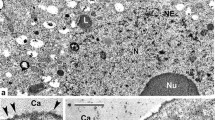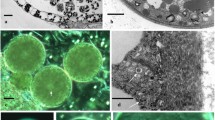Summary
In the 9 spp. ofPolystichum studied, a uniseriate germ filament is produced on spore germination. The anterior cells of the germ filament develop into a prothallial plate commonly before or sometimes after the terminal cell develops a papillate hair. A meristematic cell is differentiated early during plate formation, commonly in one of the daughter cells of the terminal cell or rarely (when the terminal cell is quiescent and hair-bearing as inP. aculeatum andP. lentum) of the penultimate cell. Young thalli become cordate inc. 8 weeks from spore germination and fully grown inc. 3 months. The mature prothallus is profusely hairy and cordate with a thick midrib and spread-out wings. Hairs are of the capped, unicellular, papillate type; a few club-shaped, unicellular hairs devoid of terminal caps are found in addition on the anterior margin. Sex organs are of the usual leptosporangiate type. The antheridium dehisces by a pore-like opening formed in the cap cell.
Similar content being viewed by others
References
Ching, R. C... “On natural classification of the Polypodiaceae,”Sunyatsenia, 1940,5, 201–68.
Christensen, C. ..Filicineae: Manual of Pteridology, ed. Fr. Verdoorn, The Hague, 1938.
Copeland, E. B. ..Genera Filicum, Waltham, Mass., U.S.A., 1947.
Devi, S. ..Spore Morphology of Indian Ferns, Ph.D. Thesis, Agra University, 1966.
Holttum, R. E... “A revised classification of the leptosporangiate ferns,”J. Linn. Soc. (Bot.), 1947,53, 123–58.
Nayar, B. K... “The gametophyte and young sporophyte ofAthyrium esculentum (Retz.) Copel.,”Amer. Fern J., 1960a,50, 194–203.
—————.. “Morphology of the gametophyte ofQuercifilix Copel.,”Lloydia, 1960b,23, 102–08.
—————.. “Morphology of the spores and prothalli of some species of Polypodiaceae,”Bot. Gaz., 1962,123, 223–32.
—— and Chandra, P... “Observations on the morphology of the gametophytes ofCyclosorus,”J. Indian bot. Soc., 1963,42, 392–400.
—————.. “The gametophyte of some species ofLastrea Bory,” Ibid., 1965,44, 84–94.
—— and Devi, S... “Spore morphology of Indian ferns. I. Aspidiaceae,”Granapalyn., 1964,5, 80–120.
-- and Kaur, S. .. “Ferns of India. XI.Peranema andAcrophorus,”Bull. natl. bot. Gards., 1963, No. 81.
—————.. “Contributions to the morphology ofTectaria; the spores, prothalli and juvenile sporophytes,”Bull. Torrey bot. Club, 1964,91, 95–105.
Stokey, A. G... “The contribution by the gametophyte to the classification of the leptosporangiate ferns,”Phytomorphology, 1951,1, 39–58.
—————.. “Multicellular and branched hairs on the fern gametophyte,”Amer. Fern J., 1960,50, 78–87.
Author information
Authors and Affiliations
Additional information
Communicated by Dr. T. N. Khoshoo,f.a.sc.
Rights and permissions
About this article
Cite this article
Nayar, B.K., Kaur, S. & Chandra, P. The prothallus ofPolystichum . Proc. Indian Acad. Sci. 69, 198–202 (1969). https://doi.org/10.1007/BF03051721
Received:
Issue Date:
DOI: https://doi.org/10.1007/BF03051721




